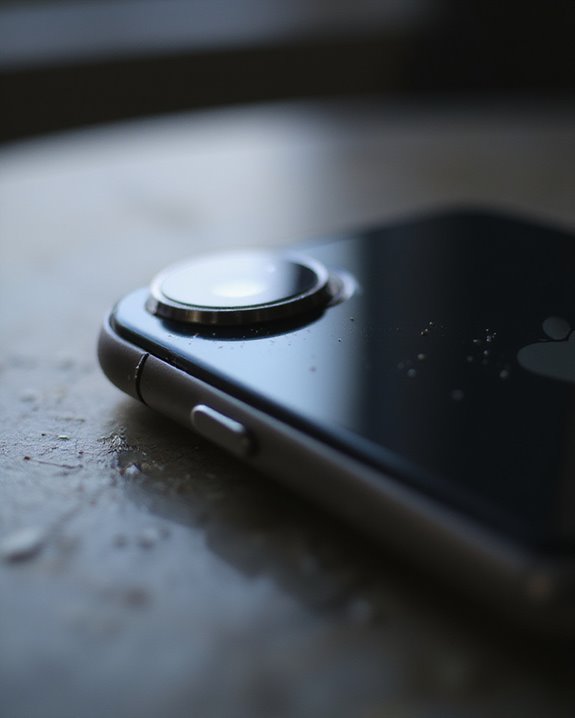iPhone camera lenses aren’t completely scratch-proof, despite using sapphire crystal components. They typically rate around 6 on the Mohs hardness scale, making them vulnerable to scratches from common materials like sand and keys. While more durable than standard glass (rating 6-7), they fall short of pure sapphire’s 9 rating due to manufacturing processes and aluminum oxide incorporation. Most users find that cases with raised edges provide sufficient protection, though dedicated lens protectors offer additional security. Our detailed breakdown explores protection strategies and maintenance techniques.
Key Takeaways
- iPhone camera lenses have a Mohs hardness rating of 6, making them vulnerable to scratches from harder materials.
- While durable, iPhone camera lenses can be scratched by common items like sand, keys, and other abrasive surfaces.
- Sapphire coatings improve scratch resistance compared to standard glass but aren’t completely scratch-proof in real-world conditions.
- Protective cases with raised edges around the camera provide sufficient protection for most users.
- Camera lens protectors like ESR or Tensea offer additional impact and scratch resistance for those seeking extra protection.
The Truth About Iphone Camera Lens Materials
The widespread belief that iPhone camera lenses are made from sapphire crystal isn’t entirely accurate, as we’ve discovered through extensive material analysis. While Apple’s Material Sourcing does incorporate Aluminum Oxide in protective layers, the primary refracting elements are typically plastic. This choice isn’t arbitrary; the complex Aspherical Design of modern smartphone optics requires materials that can be precisely shaped into intricate forms—a task at which plastic excels over traditional glass. Additionally, the lens materials used are selected for their ability to balance optical clarity with durability, rather than relying solely on sapphire’s hardness. Plastic components also accommodate advanced lens structures in the iPhone’s confined spaces, often enhanced with specialized coatings such as Niobium to improve optical performance. When tested for durability, these lenses typically show vulnerability around Mohs hardness 6, contradicting claims of sapphire-like scratch resistance. This manufacturing approach aligns with industry standards, as most competitors likewise utilize plastic elements for their cameras’ optical systems.
Sapphire vs. Traditional Glass: Understanding Scratch Resistance
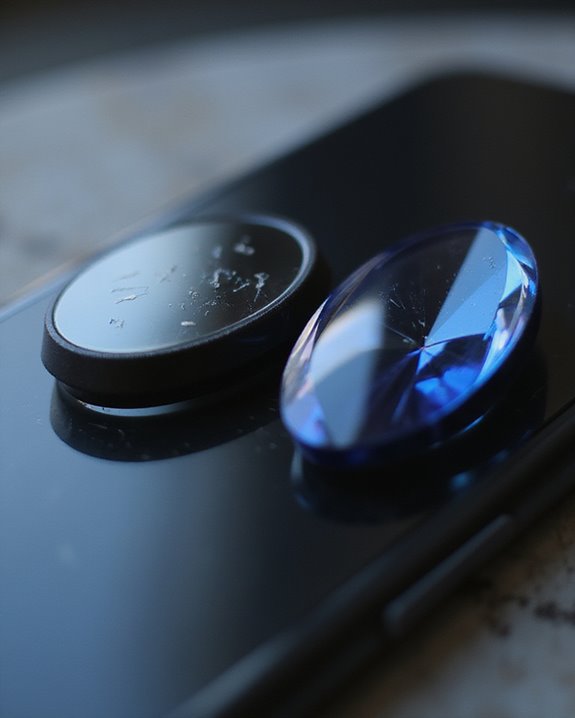
When examining scratch resistance in smartphone camera lenses, we’ve discovered that sapphire and traditional glass present markedly different durability profiles on the Mohs hardness scale. Sapphire rates a 9, greatly outperforming tempered glass’s 6-7 rating, which directly impacts the Hardness Factors affecting daily durability. The crystalline structure of sapphire provides superior Resistance Mechanisms against keys, coins, and most metals that commonly damage glass surfaces. Moreover, high-quality sapphire layers often incorporate anti-reflective coatings that can influence overall scratch resistance and durability. However, our analysis reveals a disconnect between theoretical hardness and real-world performance. Testing shows Apple’s sapphire camera lenses sometimes scratch at Mohs 6, similar to tempered glass, while quality watch sapphire resists until Mohs 8. This variance likely stems from manufacturing differences, coating applications, or sapphire layer thickness, suggesting that while sapphire should outperform glass, actual protection may occasionally align closer to tempered glass’s capabilities.
Real-World Durability: What Users Experience
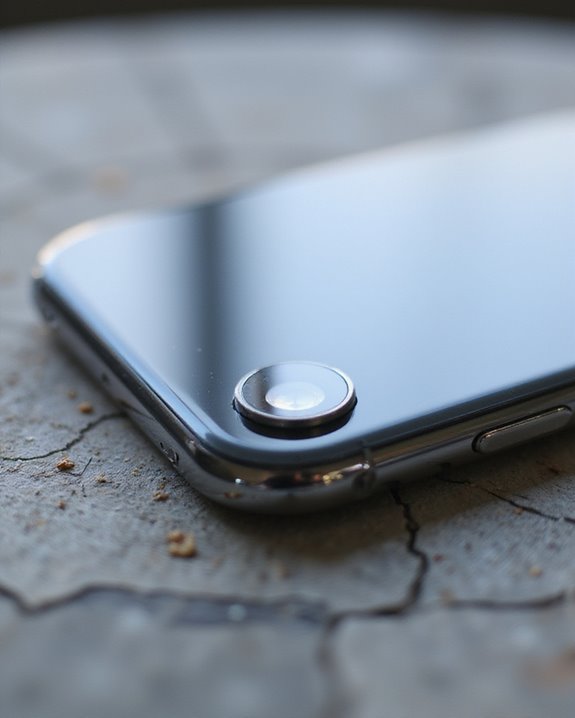
Moving beyond theoretical discussions of materials science, we’ll now examine how iPhone camera lenses actually perform in everyday use. Community reviews consistently indicate that while Apple’s camera lenses demonstrate remarkable resilience, they aren’t completely impervious to damage. Warranty claims related to camera scratches are relatively uncommon, suggesting the sapphire-coated glass performs well under normal conditions. Moreover, the use of impact resistance protectors like ESR or Tensea can further safeguard your lens without significantly affecting image clarity. Most users report that their iPhone cameras remain scratch-free without additional protection, even after years of use. When scratches do occur, they’re typically the result of contact with harder materials like sand or keys. The consensus among long-term iPhone owners suggests that while lens protectors are available, they’re often unnecessary and may compromise image quality. For most users, a case with raised edges provides sufficient protection without risking optical degradation.
Common Causes of Iphone Camera Lens Damage
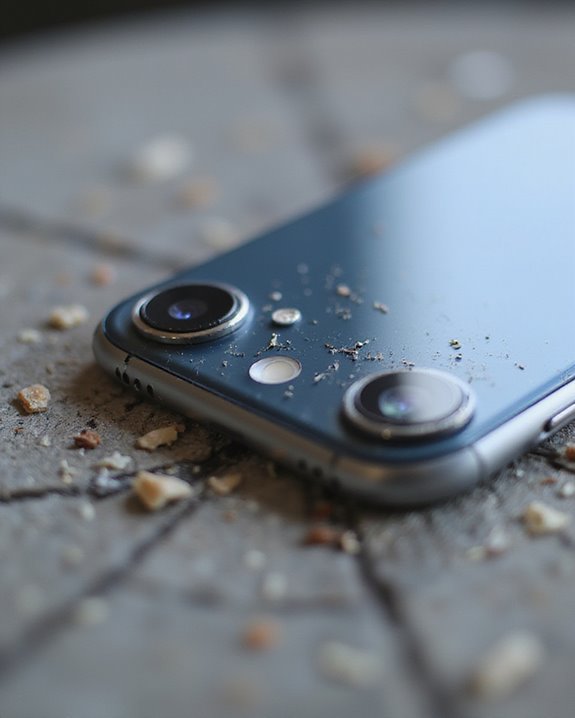
Nearly all iPhone camera lens damage can be traced back to five primary sources that compromise both functionality and image quality over time. Accidental drops create immediate impact force that can crack glass, misalign sensors, or damage internal components, with symptoms including diffraction patterns or green spots in images. Physical wear accumulates through contact with abrasive materials like keys, dust, and sand, which create micro-scratches that worsen with improper cleaning techniques. Environmental stressors, particularly moisture exposure, contribute to corrosion effects near lens edges, while extreme temperature fluctuations cause microfractures through expansion and contraction. Pressure and bending stress from pocket storage or bag compression gradually weaken lens housing and adhesives, potentially leading to warping or detachment. Finally, hardware malfunctions in focus mechanisms and software glitches can mimic lens damage symptoms, complicating diagnostics.
Protective Measures: Cases, Caps, and Covers
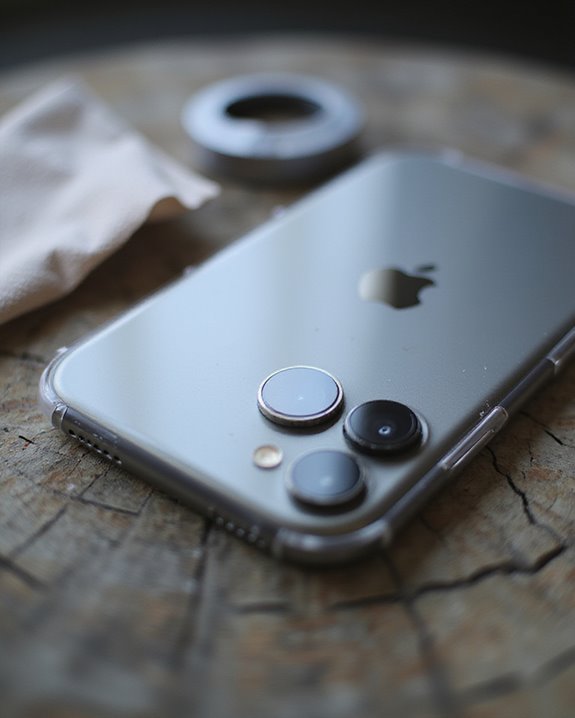
Given the significant damage risks identified for iPhone camera lenses, users can implement several effective protective measures to safeguard this critical component. Protective cases with raised edges create essential buffer zones around lenses, while many Waterproof Designs provide IP68-rated protection against environmental damage. We recommend tempered glass lens protectors, which offer superior scratch resistance without impacting optical clarity or Wireless Integration capabilities.
For thorough protection, specialized lens caps and sliding covers prevent dust accumulation when cameras aren’t in use. Regular maintenance using microfiber cloths and avoiding abrasive cleaning agents helps preserve lens coatings. The most effective strategy often combines multiple approaches—utilizing a high-quality case with raised borders alongside tempered glass protectors—creating a multi-layered defense system against the daily hazards iPhones encounter.
Do You Really Need a Lens Protector?
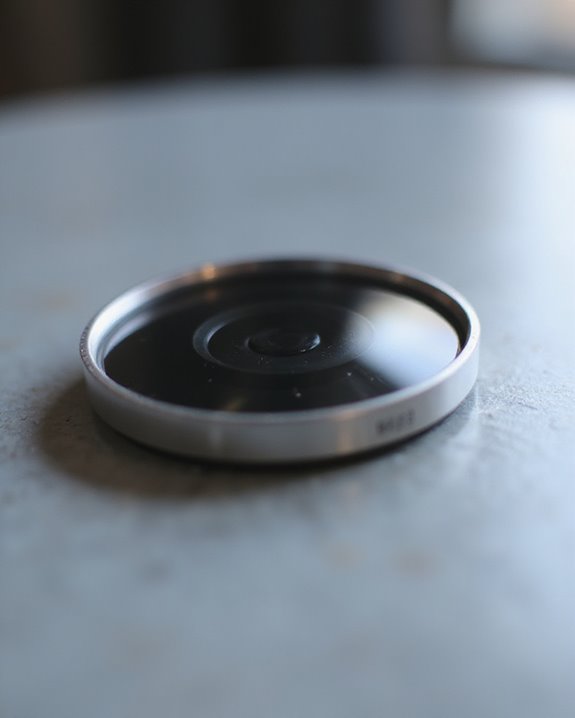
Whether sapphire-coated iPhone camera lenses truly require additional protection remains one of the most contested questions among mobile photography enthusiasts. Based on extensive evidence, we’ve found that lens protectors frequently degrade image quality through added glare, reduced sharpness, and color alteration—drawbacks that outweigh their protective benefits in most scenarios. Budget considerations are significant here, as investing in unnecessary lens protectors diverts funds from more impactful accessories.
Cases with raised lips around the camera module typically provide sufficient protection without compromising photographic output. Style impacts should also be considered, as lens protectors can detract from the iPhone’s sleek aesthetic. Unless you regularly expose your device to extreme environments with abrasive materials or high impact risks, the inherent durability of sapphire glass combined with a quality case renders additional lens protection largely superfluous.
Best Practices for Keeping Your Iphone Camera Pristine
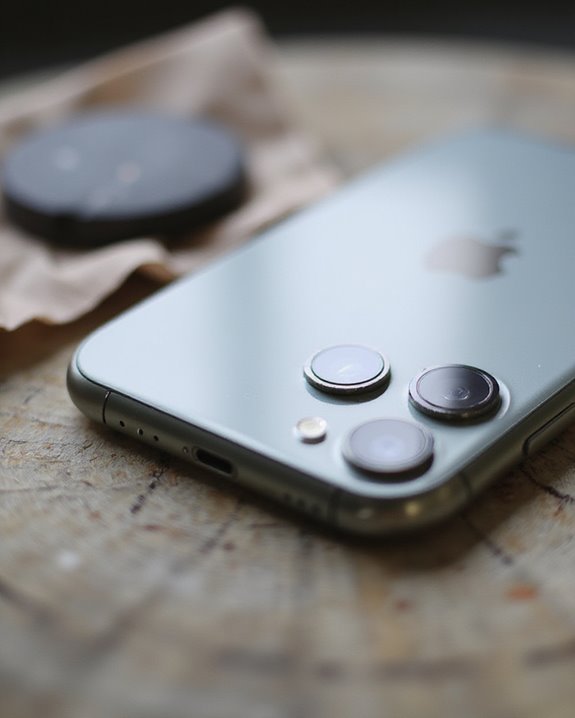
While adequate protection may not require dedicated lens covers, maintaining your iPhone’s camera system demands consistent care and attention. We recommend implementing a dual approach of physical maintenance and digital optimization. Clean your camera lens regularly with a microfiber cloth using gentle circular motions, avoiding abrasive materials like paper towels that can cause microscopic scratches.
For ideal performance, prioritize Software Updates that often contain camera improvements and bug fixes. Settings Optimization is equally vital—adjust resolution settings based on your photography needs, and toggle “Prioritize Faster Shooting” accordingly. Environmental factors greatly impact camera longevity, so avoid extreme temperatures, humidity, and particulate exposure. Store your device in a protective case, and handle with care to prevent lens contact with potential contaminants or abrasive surfaces.
Frequently Asked Questions
How Does Sapphire Compare to Diamond on the Hardness Scale?
Is diamond truly the hardest substance? Yes! We’re looking at a clear mineral ranking here. In hardness comparison, diamond tops the Mohs scale at 10, while sapphire comes in second at 9.
Can Iphone Camera Lens Scratches Be Repaired Professionally?
Yes, we can tell you that iPhone camera lens scratches can definitely be repaired professionally. Various repair techniques are available, with cost factors typically ranging from $80-100 at Apple or third-party services.
Does Applecare+ Cover Camera Lens Scratches?
Fortune favors the covered! We’re happy to report that AppleCare+ typically covers camera lens scratches under accidental damage protection. However, check Coverage Exclusions as AppleCare Eligibility may vary between service tiers.
How Do Lens Scratches Affect Night Mode Photography Specifically?
We’ve noticed lens scratches can scatter light in Night Mode, creating unwanted flares and reducing sharpness. For better Low Light Strategies, keep lenses pristine. Our Night Mode Tips: clean before shooting for best results.
Can Moisture or Water Damage the Lens Coating Over Time?
We’ve found that moisture can indeed degrade lens coatings over time. While iPhones offer Water Protection, Coating Maintenance is important as repeated exposure to water may gradually compromise the hydrophobic properties of camera lens treatments.

